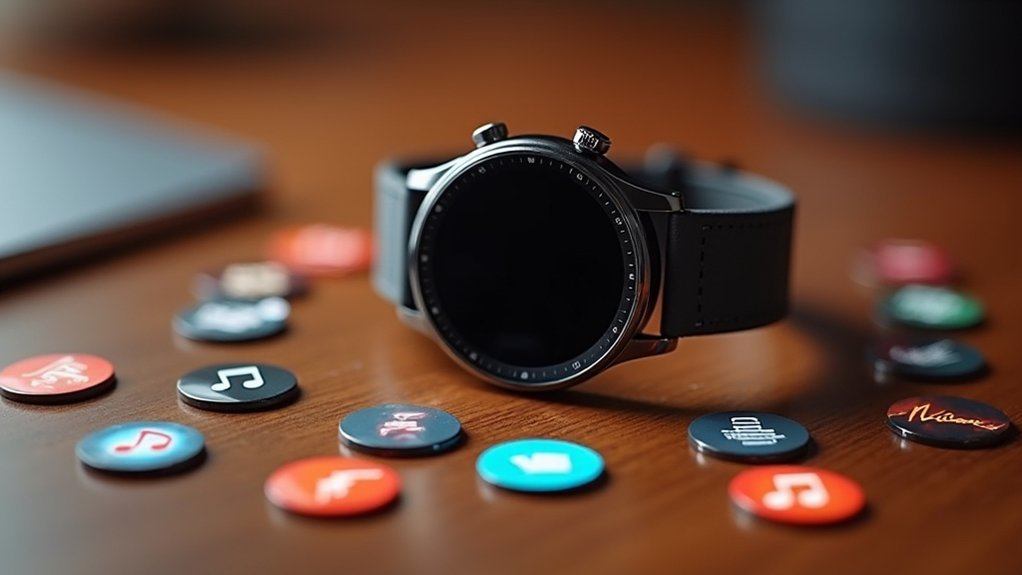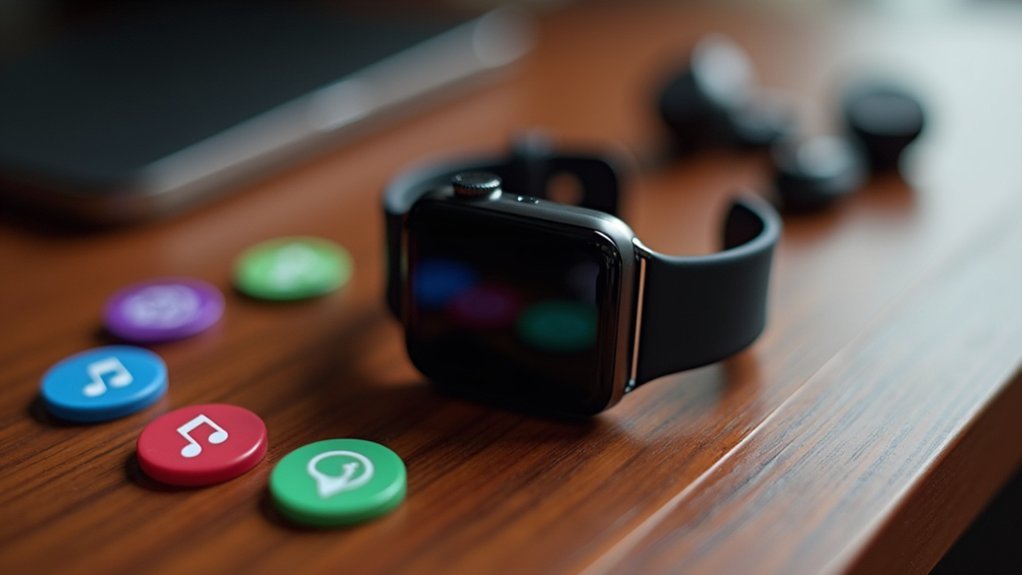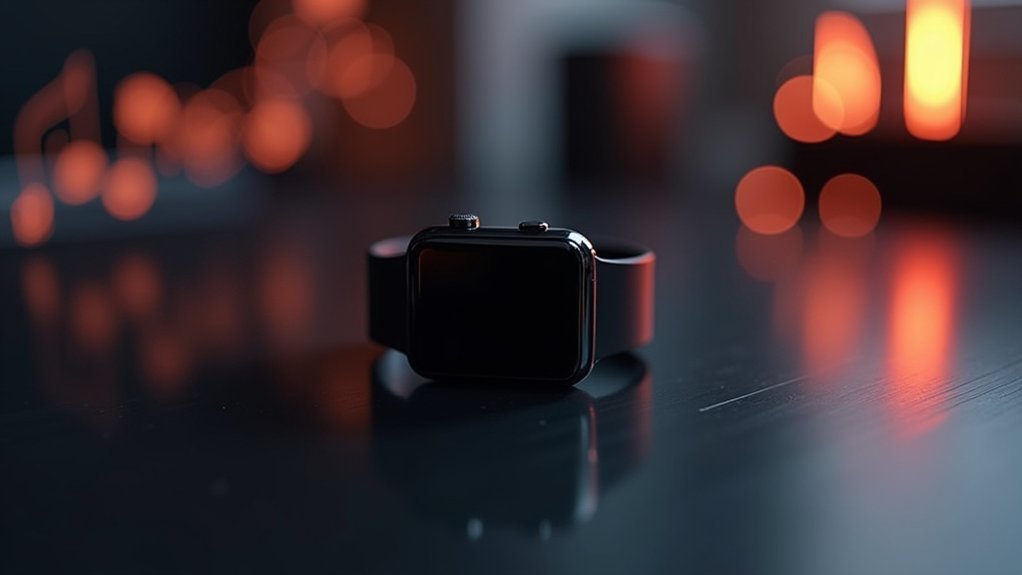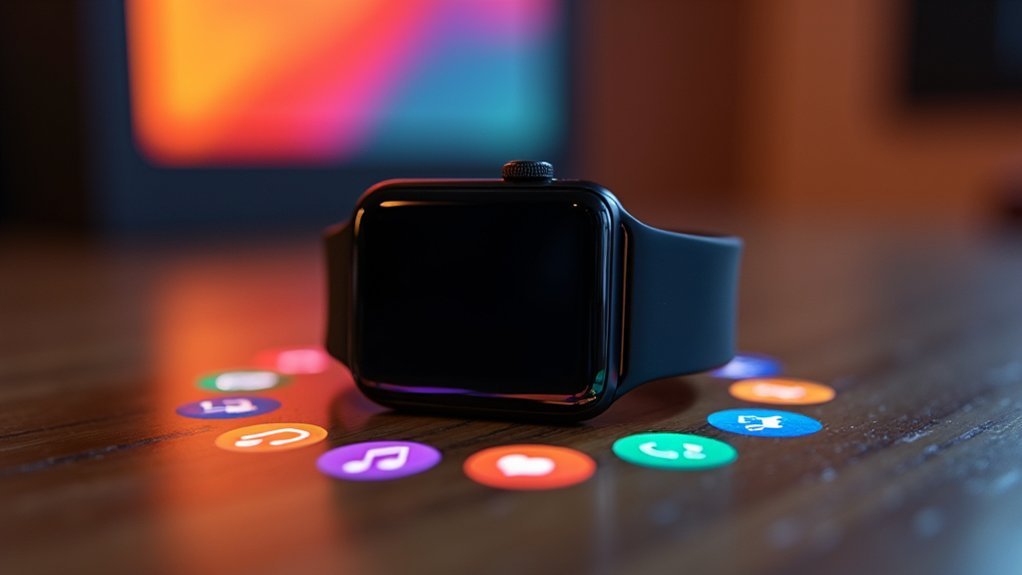You’ll find YouTube Music leads the pack for Wear OS with seamless Google integration and full offline downloads. Spotify excels at playback control and playlist browsing, though offline features are limited. Deezer offers a solid middle ground with both streaming and offline capabilities. Look for apps with intuitive touch gestures, Google Assistant support, and Bluetooth connectivity for the best experience. Performance varies by device, with flagship models like Galaxy Watch 7 optimizing functionality. Below you’ll discover the detailed features that make these apps stand out.
Top Streaming Services for Wear OS Smartwatches

When selecting a streaming app for your Wear OS smartwatch, you’ll find that YouTube Music stands out as the most extensive option with full offline download capabilities and seamless Google ecosystem integration.
You can download songs directly to your watch for phone-free listening during workouts or commutes.
Spotify offers excellent playbook control and playlist browsing through its dedicated Wear OS app, though offline functionality remains limited.
You’ll get access to personalized features like Discover Weekly directly from your wrist.
Deezer provides a solid alternative with streaming and offline listening capabilities, while niche services like Napster or Tidal offer varying functionality levels.
Your experience depends on your smartwatch model and Wear OS version, with flagship devices like Galaxy Watch 7 delivering peak performance. These Wear OS devices benefit from extensive testing in lab environments to ensure optimal compatibility with music streaming applications.
Essential Features and Functionality of Wear OS Music Apps
While choosing the right streaming service matters, understanding the core features that make Wear OS music apps truly functional will help you maximize your smartwatch’s audio capabilities.
You’ll want apps with intuitive touch gestures optimized for small screens, plus support for physical buttons and rotating crowns. Vital playback controls should include play/pause, skip, shuffle, and repeat options accessible from your watch face.
Google Assistant integration enables voice commands for hands-free control. Bluetooth connectivity is essential for pairing with wireless headphones, while Wi-Fi and LTE support allows independent streaming.
Look for apps supporting multiple audio formats and real-time device switching. Additional must-haves include integrated equalizers, playlist management, offline playback, and fitness integration that adapts music to your workout intensity without requiring your phone.
Starting from Wear OS 5, users can directly select their preferred audio output device, giving you greater control over where your music plays and enhancing the overall listening experience.
Offline Listening and Storage Capabilities

Storage limitations on Wear OS devices make offline music capabilities an essential consideration for your smartwatch experience.
You’ll want apps like NavMusic and WearMedia that enable independent listening without your paired smartphone, particularly beneficial during workouts where connectivity might be unreliable.
These apps support multiple audio formats including MP3, WAV, FLAC, and OGG, ensuring compatibility with your existing music library.
You can transfer files using NavMusic’s integrated FTP server or WearMedia’s direct transfer feature, which tracks progress and supports all file formats.
Offline listening offers significant advantages: reduced battery drain compared to streaming, uninterrupted playback regardless of internet connectivity, and complete independence from your phone.
You’ll also get playlist management, equalizer support, and intuitive interfaces for seamless navigation during offline use. Apps like Pulsar Music Player provide customizable settings that let you tailor the playback experience to your personal preferences.
Device Integration and Connectivity Options
Beyond storing music locally, your Wear OS device’s connectivity options determine how seamlessly you can enjoy audio across different scenarios.
Your smartwatch automatically detects paired Bluetooth headphones, speakers, and A2DP devices, allowing you to switch between the built-in speaker and external audio accessories effortlessly. The AudioManager APIs guarantee proper playbook routing based on your connected devices. Voice commands through Assistant provide hands-free control for situations where direct interaction with your smartwatch isn’t practical.
Seamless audio switching between your smartwatch speaker and Bluetooth accessories happens automatically through intelligent device detection and routing.
- Direct Streaming: Stream music over LTE or Wi-Fi without your phone, with YouTube Music delivering 128 kbps AAC quality directly from your wrist.
- Google Ecosystem Integration: Control playback through Google Assistant voice commands and sync seamlessly with Google Maps and Health apps for contextual listening experiences.
- Cross-Device Synchronization: Media controls and metadata updates propagate between your phone and watch, maintaining synchronized playback across all connected devices.
User Interface Design and Customization Features

As music streaming becomes increasingly visual, Wear OS 6’s Material 3 Expressive design system transforms how you interact with your favorite audio apps through fluid animations and responsive feedback optimized for round displays.
You’ll notice glanceable buttons that adapt perfectly to your watch’s circular screen, making playlist selection and playback controls easily tappable.
Dynamic color theming creates a cohesive experience by matching your music app’s interface to your watch face colors automatically.
The new tile customization framework offers a 3-slot layout for quick access to favorite artists or playlists, while shape-morphing elements guarantee smooth shifts between screens. Music tiles provide immediate access to recently played songs and allow you to quick-start your workout playlists without opening the full app.
Motion-based controls let you navigate tracks with simple gestures, and the system font alignment across tiles provides visual consistency that enhances your overall music browsing experience.
Frequently Asked Questions
Do Wear OS Music Apps Drain Battery Faster Than Other Smartwatch Applications?
You’ll find music apps drain battery faster than most other smartwatch applications. They’re resource-intensive due to streaming, background syncing, and continuous media controls, often reducing your typical 18-24 hour battery life considerably.
Can I Use Voice Commands to Control Music Playback on Wear OS Devices?
You can control music playback using voice commands through Google Assistant on Wear OS. Say “Hey Google” then request songs, artists, or playlists. Third-party apps like Spotify need specific voice syntax.
Are There Any Free Music Apps Available for Wear OS Smartwatches?
You can use Spotify’s free version with ads on your Wear OS smartwatch for basic music controls and streaming. YouTube Music also offers limited free features, though full functionality requires a subscription.
How Much Storage Space Do Music Apps Typically Require on Wear OS?
Music apps typically require 700 MB including downloads. You’ll need 60 MB per hour of offline music at 128 kbps. For workouts, expect 300-600 MB for several hours of stored songs.
Do Music Apps Work With All Wear OS Smartwatch Models and Brands?
Music apps work with most Wear OS smartwatch models and brands, but you’ll experience better performance on high-end devices like Samsung Galaxy Watch or Google Pixel Watch compared to budget models.
In Summary
You’ve got excellent music options for your Wear OS smartwatch, whether you’re streaming from top services or storing tracks offline. Make sure you choose apps that integrate seamlessly with your phone and other devices while offering the interface customization you need. Don’t forget to take into account battery life and storage limitations when selecting your preferred music solution. Pick the app that best matches your listening habits and enjoy wireless freedom.





Leave a Reply